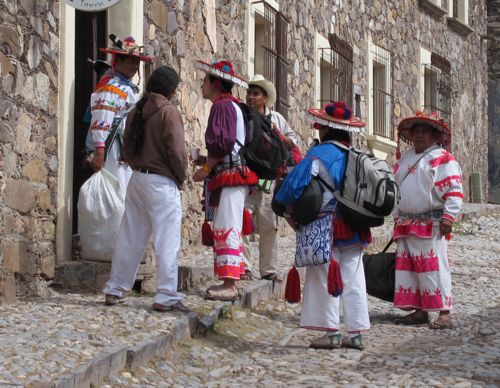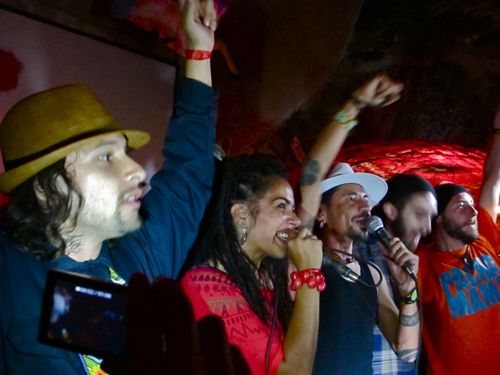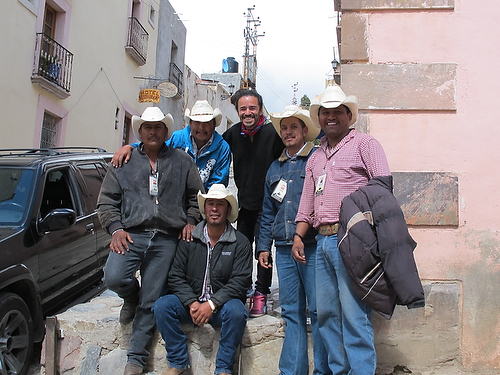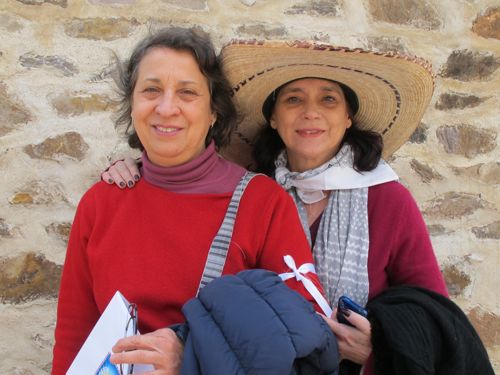
 Wixarika pilgrims in their traditional dress began arriving in this town yesterday in preparation for a historic "spiritual consultation" with their deities.
Wixarika pilgrims in their traditional dress began arriving in this town yesterday in preparation for a historic "spiritual consultation" with their deities.
This story is the second in a series about the historic pilgrimage of the Wixarika people to their sacred site of Wirikuta. Read the first part here. A report on tonight's ceremony, a consultation with the Wixarika ancestral spirits about the crisis facing the birthplace of the sun, will follow.
REAL DE CATORCE, San Luis Potosí, Mexico -- Some 800 Wixarika people -- 18 busloads -- are gathering in the desert below are expected to descend on this tiny town within an hour and will begin the trek up the sacred mountain of Cerro Quemado, the place where they believe the sun was born. Thunder is sounding in the distance, a little intimidating for a group of open-air campers given the polar front that is expected to descend tonight. Nonetheless, the local people are greeting the rains with joy, since the last hard rain was more than a year ago -- and then it was the disastrous flooding of Hurricane Alex. This time, they hope for a ground-drenching, drought-quenching downpour. And everyone around here knows the Huichols bring the rain.
Meanwhile a star-studded lineup of high-power celebrities, academics, documentarians and media notables have been arriving in this rugged colonial mountain town since yesterday. Today, Mexican actress Ofelia Medina added her name to the list of registrants, along with writer Elena Poniatowska, Ruben Albarran of Cafe Tacuba, the UN High Commissioner of Human Rights and Sandor Iron Rope, vice president of the Native American Church.
 Hector Guerra of Pachamama Crew, Moyenei and Roco of Sonidero Mestizo and Lengua Alerta were among the lineup supporting Wirikuta in Real de Catorce.
Hector Guerra of Pachamama Crew, Moyenei and Roco of Sonidero Mestizo and Lengua Alerta were among the lineup supporting Wirikuta in Real de Catorce.
And last night, a lineup of popular artists from Mexico City, part of a team that has been supporting the defense of Wirikuta with periodic concerts and events, culminated a high-voltage performance in the historic restored Paz y Amor bar and restaurant with a rousing cry that was part chant, part prayer. ""Wirikuta no se vende, se ama y se defende! (Wirikuta is not to sell, it is to love and protect!") Pachamama warriors, amor para mi gente (love for my people!)

Ruben Albarran of Café Tacuba, one of Mexico's most popular rock bands, went on the local community radio station to reassure residents of the town that they were not here to protest the mine or to impede development. "On the contrary, we're here to support the community. Our idea is to raise funds to support development projects here in the region that will provide jobs for the people without harming the environment."

Leaders of the Native American Church, the Council of Chiefs of the Sun Dance and other indigenous leaders from the United States and Canada gathered with Wixarika leaders today in preparation for tonight's historic ceremony.
"Our brothers have asked us to join them in prayer with the sacred medicine," said Chief Oscar Moreno, who came on behalf of Leonard Crow Dog. Lakota spiritual leader. Like the Wixarika or Huichol people, the Lakota and many other tribal peoples in the north pray with peyote, which they consider a sacrament. Wirikuta is one of the most important ceremonial centers for the collection and ceremonial use of peyote, and the Wixarika have been the historical guardians of the sacred hallucinogenic cactus, which they say puts them in contact with their ancestors and the spirits of the land. "We are indebted to them in this holy ground because they have cared for the medicine and they brought it to the North."
Moreno was concerned to hear the news of the planned gold and silver mines in the area. "We're very familiar with what this means, and we're here to pray in the hope that others will understand that desecrating sacred land is not a good idea for anyone."
Cilau Valadez, a young Huichol artist who has been traveling in Canada and the United States, building alliances with the different tribes through the Americas, said the visit of leaders like Moreno, Anishinabe leader Wab Kinew and Native American Church Vice-President Sandor Iron Rope represents a significant moment in Native American history.
"We are fulfilling the Hopi prophecy that speaks of a time when all the original peoples from the North and the South will come together," he said. "It means that we are one people, and that we must be recognized."
Meanwhile, rumors circulated of a pending "counterprotest" of local residents in favor of the mine as habitants of Real de Catorce watch the proceedings with a mixed feelings. "Yes to the sacred sites, yes to mining," read one banner hung at the entrance of the town. "Huichol brothers, support us, and we will support you." Another one read, "Mining, tourism and sacred sites go hand in hand. We support the environment; we only want social wellbeing."
Father Ernesto Vega Torres hears from his parishioners on both sides of the fence and worries about the future of the region, regardless of what happens. "Everything is just on hold; everyone is waiting to see what will happen with the mine," he said. "It's a very difficult situation."
He pointed to a severe water crisis in town today as businesses in the city center ran out of water entirely. Two pumps broke down due to a lack of water in the wells, he said. "It hasn't rained in more than a year; we're in the worst drought since 1917. There was no sowing because the rain never came, so there was no harvest. People's animals are dying. It's a crisis, so they want jobs. But here we run into a problem, because there's simply no water -- and mining requires a lot of water."
Volunteers with horses and burros have been preparing all week for the ceremony, carrying up the mountain a historic quantity of water, along with other supplies: 600 liters, along with firewood for 17 fires, 2,500 tamales, 30 kilos of beans, 50 kilos of coal and the stoves for cooking. An estimated 800 Wixarika are expected to arrive in the mid-afternoon.
All participants are being asked to observe a strict protocol to allow the Wixarika to conduct their ceremony without outside interference. The all-night ceremony will take place at the top of the Cerro Quemado, the sacred mountain where the Huichols believe the sun was born. They will arrive this afternoon after days with no sleep and little food, following the complicated series of activities required of all who make the pilgrimage to Wirikuta. Their rituals are meant to be a re-creation of the journey their forefathers made at the beginning of the world, and in the process, they dream the rain and the coming of the sun, and they bring the light and the rain, said Johannes Neurath of the National Museum of Anthropology, one of the invited guests.
"It's a very unique event -- something that's never happened," said Neurath. "Obviously they are very worried about what's happening here; normally they are very divided among themselves. It's very rare that they organize among themselves, and even more so that they would allow us to attend."
 Patricia Diaz, director of several documentaries about the Huichols, and actress Ofelia Medina were among the invited guests to the ceremony.
Patricia Diaz, director of several documentaries about the Huichols, and actress Ofelia Medina were among the invited guests to the ceremony.
Medina Ofelia, one of Mexico's most beloved Hollywood actresses and a longtime supporter of indigenous rights, compared the situation in Wirikuta with the Zapatistas' uprising in 1994, which she also supported. "It's the same struggle," she said. "It's for the rights of the indigenous people of Mexico, who have always been marginalized." She was looking forward to the ceremony, not her first as she has been working with the Wixarika since 1985. She wasn't sure what to expect, however. "They have taught us not to go with expectations," she said with a smile. "It's better to wait and see."
For more information about Wirikua, see www.wirikutadefensefront.org.

